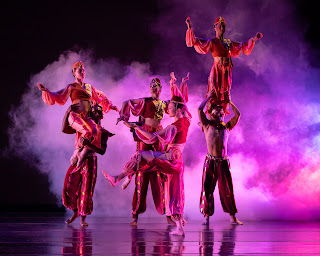Farewell tour: Departing artistic director Hochoy turns back to autobiography and a major inspiration
 |
| The harem materializes out of 'Scheherazade' mist. |
There's a freshness that David Hochoy has communicated to his well-prepared dancers over the past 32 years that has shown up regularly in Dance Kaleidoscope productions.
It's no wonder that it can be summed up, as associate director Stuart Lewis told the audience at Thursday's first intermission, this way: "You never know where your next inspiration will come from." Hochoy's open-ended encouragement of finding something new in creating and performing contemporary dance has made his long tenure as DK artistic director a monument in the local performing-arts scene.
This weekend, in a show with autobiographical resonance, marks Hochoy's conclusion in that role, with the lion's share of new pieces in DK repertoire being his creation. The main stage at Indiana Repertory Theatre is the site of this milestone, and may be experienced through Sunday.
As the main creative force behind the company, Hochoy's "next inspiration" also draws upon the past, with the troupe's changing personnel over the years prompting reimagined choreography of pieces brought back on the schedule. The season's final program contains two such works with the current dancers: "Scheherazade" (1992) and "China Boy" (2002).
The latter work is steeped in Hochoy's family history, stemming from origins in China and transplanted to Trinidad, where the dancer-choreographer was born 72 years ago. Hochoy sets up the choreography with a spoken introduction, introducing the dancers according to the characters they represent. In this reiteration, Kieran King has the title role, with Paige Robinson playing the Mother. The piece goes a generation further back, with Emily Dyson and Cody Miley as the Grandparents and five dancers as their children, including David Hochoy's father (Manuel Valdes).
The piece brings forward the authenticity of Hochoy's background in dress (costumes are by Cheryl Sparks), music, and gesture. It is also naturally family-centered, without sentimentality. But emotional genuineness and Hochoy's well-honed ability to be straightforward and tender at the same time come through in "China Boy." The arranged marriage of the Grandparents gets a sensitive portrayal, as the unknown becomes known in a smooth progression that probably sums up years of the couple accustoming themselves. Their offspring were represented by a frisky episode of childlike abandon, making for a lively contrast to the more restrained and intimate parts of the work.
The solos for Mother and son conveyed that well. There was a brief moment that seemed to me to represent a vision of himself as a dancer that Hochoy, originally headed for a medical career, might have had in adolescence. Kieran King grasped his right wrist with his left hand, so that the right hand was positioned close in front of him, palm toward his face, the fingers in a supple waving motion. It seemed kind of a miniaturization of dance movement, with a symbolic assertion that "this is it — this is what I'm meant to do."
Paige Robinson has long stood out for me among the DK women for her nobility of expression, with a face of sculptural dignity and poise, linked fortunately to eloquence of movement from head to toe. There is something of a Chekhovian quality to her, the ability to represent what Wordsworth called "the still, sad music of humanity." That may seem like quite a lot of literary baggage to load onto one dancer, but it sprang to mind Thursday in the Mother's solo. The choreography had recurring cradling motions, almost a Madonna-and-child aura. There was a sustaining sense of nurture to it, linked to the regret of having to abandon that function, as China Boy goes on his own way, maternal love trailing behind him as permanently as life allows that to happen. The scene was, to use a recently worn-out word, iconic.
A particularly complete departure leaves the seafaring depictions out of the scene. The narrative is implied mostly in the danger-and-rescue progression in the first act, where the spectacle reaches a peak with the crucial aid of Barry Doss's costumes, enhanced all the more by the wizardry of Laura E. Glover's lighting. Visually, this aspect of the production privileges orientalism to a heightened degree, but I hope without controversy of the sort that Edward W. Said scrutinized in his book of that title. I would argue that Rimsky-Korsakov's score, with its lavish picturesqueness and its deliberate representation of the storyteller Scheherazade as seductive in the most life-affirming sense, makes Hochoy's treatment an inevitable part of our cultural legacy.
 |
| David Hochoy has shaped Dance Kaleidoscope since 1992. |
Hochoy's representation of that climax, by the way, is less cataclysmic, more exuberant and freely representative of gender roles in the upper reaches of the Arabian Nights social structure. There's a harem, a group of male courtiers, and the full company coming into play as messengers, who tie the meaning of all the collective dazzle into an exotic bow.
Long ago, Hochoy told me as a Star reporter of his heartfelt affinity for "Scheherazade," and it's clear in his version's occasional revival since its 1992 premiere that his choreographic imagination was never more extravagant and productive than it is here. The season-ending program adds up to a perfect self-sendoff into retirement of this superb creative artist. For the public, it's also representative of David Hochoy's unique abundance of contributions to Indianapolis performing arts.
[Production photo by Lora Olive]



Comments
Post a Comment